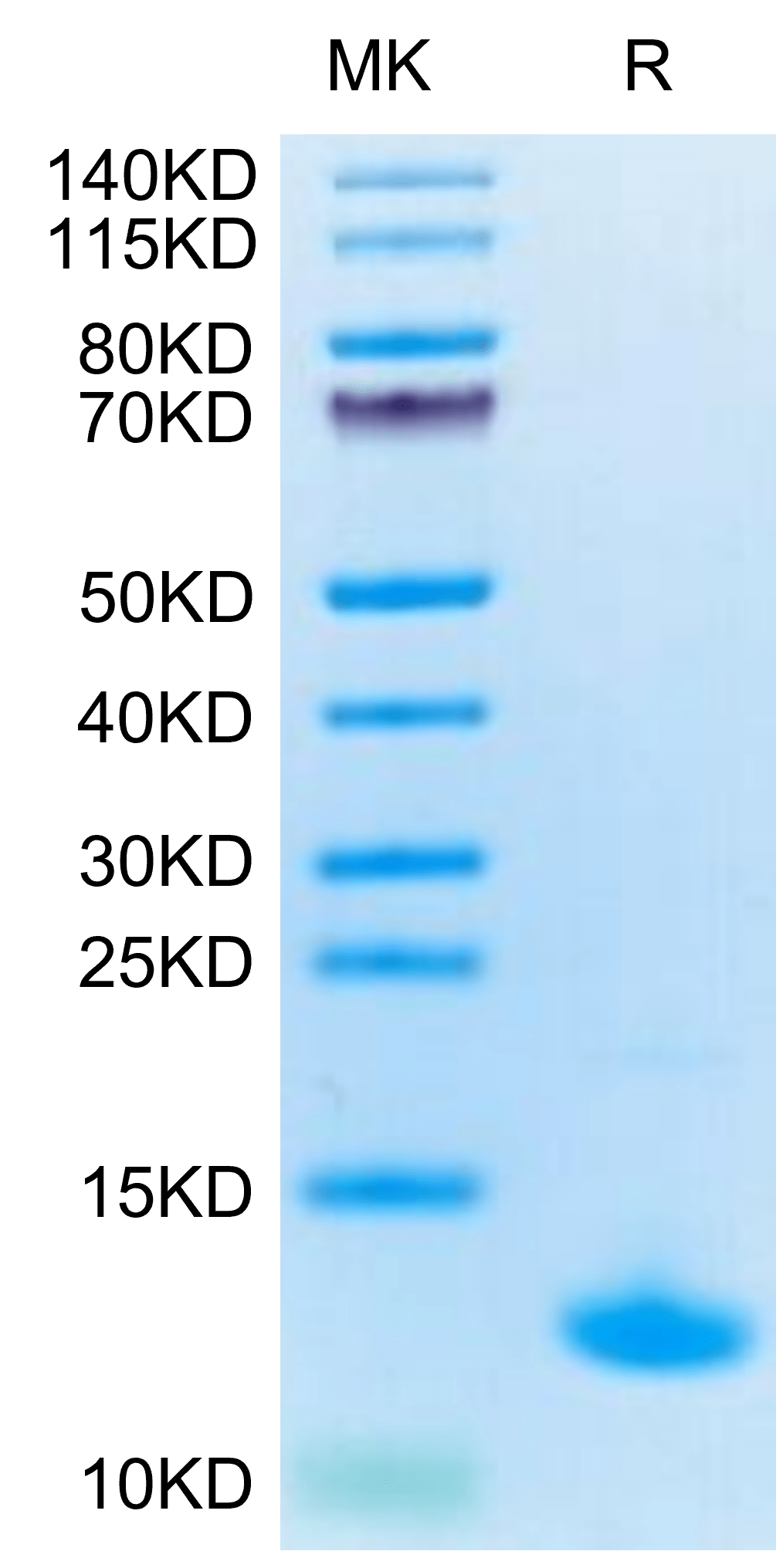| Weight | 1 lbs |
|---|---|
| Dimensions | 9 × 5 × 2 in |
| accession | XP_005555067 |
| express system | E.coli |
| product tag | N-His |
| purity | > 95% as determined by Tris-Bis PAGE |
| background | C-X-C motif ligand 10 (CXCL10), or interferon-inducible protein-10, is a small chemokine belonging to the CXC chemokine family. Its members are responsible for leukocyte trafficking and act on tissue cells, like endothelial and vascular smooth muscle cells. CXCL10 is secreted by leukocytes and tissue cells and functions as a chemoattractant, mainly for lymphocytes. |
| molecular weight | The protein has a predicted MW of 8.36 kDa. The protein migrates to 12-14 kDa based on Tris-Bis PAGE result. |
| available size | 100 µg, 500 µg |
| endotoxin | Less than 1EU per μg by the LAL method. |
Cynomolgus CXCL10 Protein 2843
$315.00 – $1,050.00
Summary
- Expression: E.coli
- Pure: Yes (SDS-PAGE)
- Amino Acid Range: Thr27-Lys91
Cynomolgus CXCL10 Protein 2843
| protein |
|---|
| Size and concentration 100, 500µg and liquid |
| Form Liquid |
| Storage Instructions Valid for 12 months from date of receipt when stored at -80°C. Recommend to aliquot the protein into smaller quantities for optimal storage. Please minimize freeze-thaw cycles. |
| Storage buffer Shipped with dry ice. |
| Purity > 95% as determined by Tris-Bis PAGE |
| target relevance |
|---|
| C-X-C motif ligand 10 (CXCL10), or interferon-inducible protein-10, is a small chemokine belonging to the CXC chemokine family. Its members are responsible for leukocyte trafficking and act on tissue cells, like endothelial and vascular smooth muscle cells. CXCL10 is secreted by leukocytes and tissue cells and functions as a chemoattractant, mainly for lymphocytes. |
| Protein names C-X-C motif chemokine 10 (10 kDa interferon gamma-induced protein) (Gamma-IP10) (IP-10) (Small-inducible cytokine B10) [Cleaved into: CXCL10(1-73)] |
| Gene names CXCL10,CXCL10 INP10 SCYB10 |
| Protein family Intercrine alpha (chemokine CxC) family |
| Mass 10881Da |
| Function Pro-inflammatory cytokine that is involved in a wide variety of processes such as chemotaxis, differentiation, and activation of peripheral immune cells, regulation of cell growth, apoptosis and modulation of angiostatic effects (PubMed:11157474, PubMed:22652417, PubMed:7540647). Plays thereby an important role during viral infections by stimulating the activation and migration of immune cells to the infected sites (By similarity). Mechanistically, binding of CXCL10 to the CXCR3 receptor activates G protein-mediated signaling and results in downstream activation of phospholipase C-dependent pathway, an increase in intracellular calcium production and actin reorganization (PubMed:12750173, PubMed:19151743). In turn, recruitment of activated Th1 lymphocytes occurs at sites of inflammation (PubMed:12663757, PubMed:12750173). Activation of the CXCL10/CXCR3 axis also plays an important role in neurons in response to brain injury for activating microglia, the resident macrophage population of the central nervous system, and directing them to the lesion site. This recruitment is an essential element for neuronal reorganization (By similarity). |
| Subellular location Secreted . |
| Tissues Mainly secreted by monocytes, endothelial cells as well as fibroblasts. Expressed by epithelial cells in thymus (PubMed:11157474). Microglial cells produce CXCL10 in response to viral stimulation (PubMed:12663757). |
| Structure Monomer, dimer, and tetramer (PubMed:12737818). Interacts with CXCR3 (via N-terminus) (PubMed:19151743). |
| Post-translational modification Several proteases can mediate post-secretion cleavages. DPP4 cleaves CXCL10 on its N-terminal 2 amino acids leading to an antagonist form of CXCL10. This dominant negative form is capable of binding CXCR3 but does not induce signaling. MMP9 cleaves 9 amino acids instead. |
| Target Relevance information above includes information from UniProt accession: P02778 |
| The UniProt Consortium |
Publications
Publications
| pmid | title | authors | citation |
|---|---|---|---|
| We haven't added any publications to our database yet. | |||
Protocols
| relevant to this product |
|---|
Documents
| # | ||
|---|---|---|
| Please enter your product and batch number here to retrieve product datasheet, SDS, and QC information. | ||















